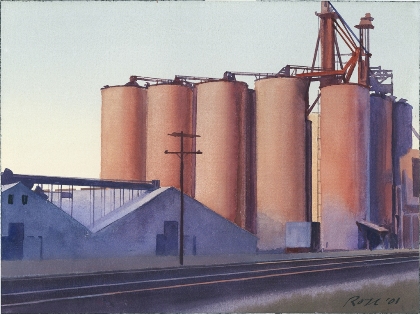Ted Rose Paintings and Photographs Exhibition at the California State Railroad Museum
Railroads and the Industrial Landscape
Offered a provocative interpretation of America’s shared railroad heritage
November 2006
November 2006, the fine arts exhibition Railroads and the American Industrial Landscape: Ted Rose Paintings and Photographs opened at the California State Railroad Museum. This exhibition recognized the work of Ted Rose, a Milwaukee-born artist who achieved national significance in organizations such as the American Watercolor Society and the National Watercolor Society. Offering viewers the opportunity to experience the nobility and beauty of railroads and industry in the 20th century, the exhibition included a selection of 40 photographs and watercolor paintings, all highlighting the artist’s fascination with the imagery and culture of railroading. The Ted Rose exhibition continued through January 2007.
For Ted Rose (1940-2002), railroads were a favorite subject of study. In his mind, trains and railroad yards retained a human scale, bound up inextricably with local culture. Rose infuses this perceived humanity into his images, with rare insight grounded in artistic realism. This exhibition made an important contribution to our understanding of railroads and industry as seen through the artist’s eyes. Subject matter aside, it was a fine display of work by an accomplished artist.
Born in Milwaukee, Wisconsin in 1940, Ted Rose developed a life-long passion for railroads after a family trip to the Chicago Railroad Fair in 1949. While in high school and college, he spent his summers working in the art department of Trains magazine in Milwaukee. Between 1956 and 1962 Rose traveled the rails in North America, photographing the last of steam locomotives operating in their vernacular environments. These experiences included several trips to Mexico and South America. Many of his photographs had never before been exhibited.

" Bounty" by Ted Rose (Copyrighted 2001, Not For Reproduction)
In 1962, Rose received his BFA from the University of Illinois at Urbana-Champaign. Following a 12-month tour of duty in Vietnam, he moved to New Mexico in 1965, ultimately settling in Santa Fe. It was there that he met his wife, Polly; built an adobe studio and home; and raised his family. In addition, during these New Mexico years, Rose worked as an independent graphic designer and as Graphics Director for the City of Santa Fe throughout the 1970s.
Ted Rose returned to painting in 1983 and quickly became a prolific, full-time artist. He completed over 1,000 watercolors in the 20 years prior to his death in 2002. Both his photographs and his paintings demonstrate Rose’s disciplined eye and expressive tendencies—all are evocative interpretations of an industrial era now rapidly vanishing from the American view. Rose captured not just trains, but the very culture of railroads; how machinery and industry intersected with humans and their communities.
Rose exhibited his works at the Norman Rockwell Museum in Stockbridge, Massachusetts (2000); the Museum of New Mexico (2000); and the California State Railroad Museum (1999). A signature member of the American Watercolor Society (1993) and the National Watercolor Society (1999), his works are included in the collections of the Colorado Railroad Museum, the Minnesota Transportation Museum, and the California State Railroad Museum
Conceived and produced by the Center for Railroad Photography & Art , in collaboration with the California State Railroad Museum, Railroads and the American Industrial Landscape was originally produced through a partnership between the Center for Railroad Photography & Art and the Haggerty Museum of Art, Marquette University, Milwaukee. The exhibition was curated by Dr. Curtis L. Carter, Director of the Haggerty Museum.
Operated by California State Parks with financial assistance from the nonprofit California State Railroad Museum Foundation, the California State Railroad Museum is open daily from 10 a.m. to 5 p.m. except Thanksgiving, Christmas, and New Year’s Day. Widely regarded as North America’s finest and most popular railroad museum, the complex of facilities includes the 100,000-square foot Railroad History Museum plus the reconstructed Central Pacific Railroad Passenger Station and Freight Depot, 1849 Eagle Theatre, and Big Four and Dingley Spice Mill commercial buildings in Old Sacramento State Historic Park. For updated 24-hour information, call (916) 445-6645 or visit www.californiastaterailroadmuseum.org.
The Center for Railroad Photography & Art is a nonprofit arts organization dedicated to the preservation and presentation of significant images of railroading. It publishes a quarterly journal, Railroad Heritage, and hosts several conferences annually on the significance and history of railroad photography and art. Rather than maintain its own museum space, the Center collaborates with other institutions and scholars to produce programs for the public.
